This article was co-authored by Ikaika Cox. Ikaika Cox is the Shop Director at the Salt Lake City branch Bicycle Collective in Salt Lake City, Utah. He has been a bike mechanic since 2012, beginning as a volunteer with the Provo Bicycle Collective, and growing and honing his skills as a bicycle mechanic and educator in multiple Bicycle Collective locations over the years. He now leads the Salt Lake City branch of the Bicycle Collective.
wikiHow marks an article as reader-approved once it receives enough positive feedback. In this case, 85% of readers who voted found the article helpful, earning it our reader-approved status.
This article has been viewed 89,207 times.
Zooming through the trees on two wheels is an addictive experience and mountain biking is a popular extreme sport for just that reason. If you're interested in learning what it feels like, you can get prepared properly for your first trails, develop the skills necessary to negotiate those trails comfortably, and find trails that'll fit your skill level and interests.
Steps
Getting Prepared
-
1Get an appropriately-sized mountain bike. Your bike should match your height, body type, and the length of your leg. If a bike doesn’t fit you well, then it will be uncomfortable and inefficient to ride. A good bike shop will be able to set you up with a bike specific to your needs.[1] Many will offer repair, service plans or discounts on future purchases. In general, there are three styles of mountain bike that you can check out, depending on your interests:
- Rigid mountain bikes have no suspension, meaning that there are less mechanical parts to worry about on your bike, and you can transition to riding it and learning the parts more easily. It's more difficult to ride off-road, however, offering none of the cushioning effects of more complicated bikes.
- Hardtail bikes are good for most beginners who want to start tackling difficult terrain, offering--as the name suggests--a suspension fork on the front wheel and a rigid back wheel.
- Full suspension bikes are the most expensive kind of mountain bike, but offer suspension in both the front and back, making them the most effective and comfortable bike to ride on the kind of difficult road mountain biking demands.
- You don’t need to buy a bike right off the bat, so consider borrowing one for a few rides to see if mountain biking is right for you. Bike shops near some state parks featuring trails will often rent appropriately-sized bikes, so check out your options. There is no use in investing hundreds of dollars in a brand new bike if it's something you won't enjoy.
-
2Get a helmet that fits properly. A good helmet should be priority one if you want to start cycling off-road. Your helmet should fit snugly, but not obscure your vision or pull down hard over your ears. Never go mountain biking without a proper helmet.[2]Advertisement
-
3Consider extra safety gear. While not necessary for your preliminary rides, there are several pieces of safety equipment you can get, at varying levels of expense. As you progress further into the sport, you may find you require more, but it's entirely up to you, your riding style, and your needs. Some mountain bikers would consider a trail incomplete without:
- Gloves
- Shinguards
- Arm braces
- Water bottle
-
4Come prepared to take a beating. On your first rides, and probably most rides afterward, it's likely that you'll fall at some point, and certain that your bike will take a beating. You'll be catching air, riding over rocks, bumping up against branches, and tearing around having a great old time on your bike. You might get some scratches and bruises on your first couple of rides, so prepare for light abrasions. It’s also a good idea to carry water and a phone with you when you ride. Make sure you or someone in your group has:
- Plenty of water
- Band-aids and blister kits
- Patch kit and multi-tool
- Small air pump
- Extra socks
- Rain gear or warm clothes
-
5Get in shape. Mountain biking is part nature walk, part aerobic exercise, and part BMX. Other than a good bike, a healthy body will be your most important piece of gear. You don't want to get out into the middle of a trail with steep grades and realize you're too tired to hoof it back. While most mountain bikers, even experienced ones, will often get off their bikes and walk especially difficult turns in the trail, it's generally easier to stay on your bike and keep your momentum going. Stopping and starting too much because you're out of shape will eventually make the ride more difficult, instead of less.
- If you haven't ridden a lot lately, but want to start mountain biking, go on some long rides to get comfortable being on a bike again. Go several miles, alternating between cruising and sprinting to get yourself back into good bike shape.
Building Skills
-
1Start slow. Get comfortable on your bike first, adjusting the seat and handle-bars to the proper specifications so you'll feel comfortable riding. You don't need to hit up master-level trails or start free-riding to learn to mountain bike. Find some unpaved but level ground to ride on to get used to the different feel of biking on a less-than-smooth surface. Ride it around in the grass to get comfortable and get the bike dialed in. Next, work up to some hills to practice your shifting and balance on your bike.
- Try riding off curbs or doing bunny hops to prepare before heading out on the trails.
-
2Look ahead, not down. When you're on a trail, especially, you want to keep your eyes scanning about 15 yards (13.7 m) ahead of you for obstacles, low-hanging branches, and steep turns that'll come up in the trail. It can be tempting to lock your eyes on a particular turn or branch and look it toward you, causing you to lose your balance and ignore the upcoming obstacles. You'll have an easier time staying balanced and letting the bike do the work for you.
-
3Brake properly. Experienced mountain bikers learn to shift their weight slightly to increase the braking effect on their bike without braking for very long. It's more of a controlled fall than an extreme slowing down.
- When going downhill, push your bottom back in the saddle so you’re crouching over your rear wheel. Apply your brakes evenly. Clamping too hard on the front can cause you to flip, while brake too much on the back can cause you to go into a skid, so be careful. There's more weight carrying you with the front tire, so use that brake to slow yourself and control your descent.
- It can be tempting at first to want to clamp onto the bike brakes as soon as you see your first steep downhill, narrow channel, or gnarly turn. On the trail, try to avoid riding your brake and instead learn to use speed to your advantage over difficult obstacles. The bike is made to take the beating for you, and it's easier to lose your balance at slower speeds, making the obstacles more dangerous.
- If you want to learn to control speed, “feather” the brakes by putting slight pressure on them at the same time.
-
4Learn the correct up and downhill techniques. Approaching grades effectively will keep you moving through the course quickly and comfortably, maximizing your efficiency.[3] Learning to properly negotiate up and downhills is a big part of mountain biking:
- When you're going uphill, stay seated and lean forward into the hill. On the road, standing can give you extra power in your pedals, but it can make you spin out on dirt. Keep your butt in the seat. Go easy on the pedaling to go light on the chain and downshift before you hit the hill, then pedal, pedal, pedal.
- When you go downhill, the most important thing is to relax. Lower your saddle, and don't oversteer or try to control things too much. Stay focused on obstacles, and stand up off the seat, keeping your pedals parallel to the ground. Don't lock your elbows or joints, which can be quite painful if you jam a tire or flip.
-
5Develop the proper shifting technique. Shifting gears allows you to slip the bike chain onto a smaller or larger diameter gear on the bike, making the pedaling require more or less power to pedal, respectively. It's important to try to shift before it becomes absolutely necessary for you to do so, anticipating up-hills that will require you to shift up and switching gears before you'll be slowing down considerably.[4]
- Shift after a power-stroke. If you feel you need to lessen the power it takes to pedal, make one extra-hard stroke, followed by a "soft stroke" that you'll earn yourself with the momentum you created. Shift on the soft stroke to make sure the chain slips appropriately.[5]
-
6Keep pedaling and stay on your bike. Speed is your friend. Going quickly means you can work less hard and use momentum to your advantage, maximizing the efficiency of your bike and your body. Keep moving and try not to slow down too much, even if you're concerned about a grade. Keep moving and the bike will do the work for you.
- At the same time, don't be foolish. Slow down, stop, and check out extremely difficult-looking turns or descents before you blunder into them too quickly. When you're first starting out, stick to beginner trails and take it easy anyway.
-
7Ride with company. One of the best ways to build mountain biking skills is to go out and hit the trails with experienced riders. When you’re actually on the trails, don’t try to hit every jump, root, and rock or keep up with more the experienced people. Go at your own pace and skill level, your technique will mature with time. Be sure and wear your helmet and keep riding and having fun.
Finding Trails
-
1Talk to your local bike shop employees. Other riders in your area should be familiar with local places that allow bicycles on their trails. Many state parks have some that are built specifically for mountain biking. Also, in many towns, there are clubs that will build and maintain trails specifically for riding. Learn which would be most appropriate for the beginner and check it out with some other mountain bikers to learn. Common mountain bike trail locations include:
- State or national parks
- Fire roads
- Rural access roads
- Private property (with permission)
- Look for trail-finding apps to help locate new trails and read reviews from other bikers who have used them.
-
2Learn the rules. When you're riding trails, you need to stick to bike-friendly trails and give pedestrians the right of way. Often, beginner trails will also be walking trails, and sometimes you'll come across hikers, dogs, people on horses, and children playing, so it's important to stick to the rules and watch what you're doing. Don't go too fast if it's an especially busy day on the trail, and don't blindly shoot around corners. Be sure to be aware of other riders around you and step off the path when they approach you from behind.
- Don't be one of the cyclists that gives the community a bad reputation. Don't shoot around people walking and spray sod in their face. The road doesn't belong to you. It's shared.
-
3Walk the trails first. It's common to want to familiarize yourself with parts of the trail while walking. It's a good idea to know what you're expecting, where the big hills are, and what you're going to need to do. It can be a fun project to scout your trail, making the first ride through it all the more exciting. Think of it less as "ruining a surprise" and more as "preparing like a pro."
-
4Seek out well-known and popular trails. Lots of online and local communities exist which can help you find trails in your area, but you also might consider making the trip to a popular mountain biking destination, once you get some experience with the sport.[6] Colorado and North Carolina are the two states with the most mountain biking trails in the US. Some popular and scenic trails rated for the beginner include:
- Rustler's Loop in Fruita, CO
- Dead Horse Point State Park in Moab, UT
- Bell Rock Trailway in Sedona, AZ
- Blue Heron in Greensboro, NC
- Evans Loop in Morrisville, NC
Expert Q&A
-
QuestionIs it safe to ride through potholes on a mountain bike riding on a dirt road?
 Ikaika CoxIkaika Cox is the Shop Director at the Salt Lake City branch Bicycle Collective in Salt Lake City, Utah. He has been a bike mechanic since 2012, beginning as a volunteer with the Provo Bicycle Collective, and growing and honing his skills as a bicycle mechanic and educator in multiple Bicycle Collective locations over the years. He now leads the Salt Lake City branch of the Bicycle Collective.
Ikaika CoxIkaika Cox is the Shop Director at the Salt Lake City branch Bicycle Collective in Salt Lake City, Utah. He has been a bike mechanic since 2012, beginning as a volunteer with the Provo Bicycle Collective, and growing and honing his skills as a bicycle mechanic and educator in multiple Bicycle Collective locations over the years. He now leads the Salt Lake City branch of the Bicycle Collective.
Bicycle Mechanic Potholes are usually very rough obstacles to ride through. They pose a danger for your wheels and for you and your bike as a whole if you ride over one without anticipating it. Typically, I avoid potholes when I ride. If I can’t avoid a pothole, I will stand up off the saddle and ride over it very carefully. Practice on shallower potholes to build your skills, and don’t hesitate to stop and dismount if the riding conditions seem unsafe.
Potholes are usually very rough obstacles to ride through. They pose a danger for your wheels and for you and your bike as a whole if you ride over one without anticipating it. Typically, I avoid potholes when I ride. If I can’t avoid a pothole, I will stand up off the saddle and ride over it very carefully. Practice on shallower potholes to build your skills, and don’t hesitate to stop and dismount if the riding conditions seem unsafe. -
QuestionHow can I get into a cycling competition?
 Community AnswerFind your local cycling club and go for it! They almost all have races. Watch one that’s hosted and observe what people are riding, wearing, and what you’ll need to accomplish in order to participate.
Community AnswerFind your local cycling club and go for it! They almost all have races. Watch one that’s hosted and observe what people are riding, wearing, and what you’ll need to accomplish in order to participate. -
QuestionDo you need gears to mountain bike?
 Dexter StevensCommunity AnswerYes, you do need gears. Without them, you can't climb or descend safely, so you'll be needing gears.
Dexter StevensCommunity AnswerYes, you do need gears. Without them, you can't climb or descend safely, so you'll be needing gears.
Things You'll Need
- Helmet made specifically for bicycling.
- Bicycle made for off-road trails.
Warnings
- Always wear a helmet and take the proper safety precautions when mountain biking.⧼thumbs_response⧽
References
- ↑ http://www.bikeradar.com/us/gear/article/beginners-guide-to-mountain-biking-part-1-23675/
- ↑ https://bikeleague.org/content/bike-helmets
- ↑ http://www.active.com/triathlon/articles/12-tips-for-transitioning-from-pavement-to-dirt?page=1
- ↑ http://www.active.com/mountain-biking/articles/the-basics-mountain-bike-skills-you-need-to-know-875964
- ↑ http://www.active.com/mountain-biking/articles/beginner-s-guide-to-gears-on-your-mountain-bike-881942
- ↑ http://www.singletracks.com/blog/mtb-trails/beginner-mountain-bike-trails-western-edition-part-1/
About This Article
To start mountain biking, begin by choosing a mountain bike that matches your height and body type so that you can ride as efficiently as possible. Additionally, make sure you have a helmet and other safety gear, such as gloves and shin guards, to prevent serious injury if you fall. On your first ride, focus on getting comfortable on your bike and becoming used to the feel of unpaved ground. As you ride, keep your head up so that you're looking ahead, which will help you stay balanced and keep an eye out for any obstacles. For advice on how to find the best trails for beginning mountain bikers, read on!
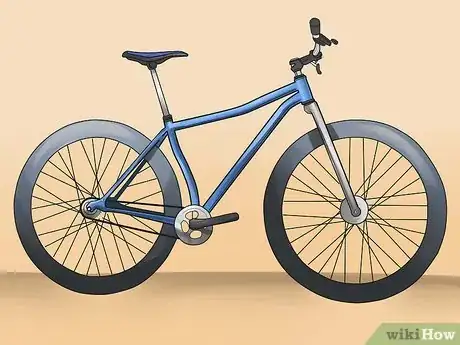
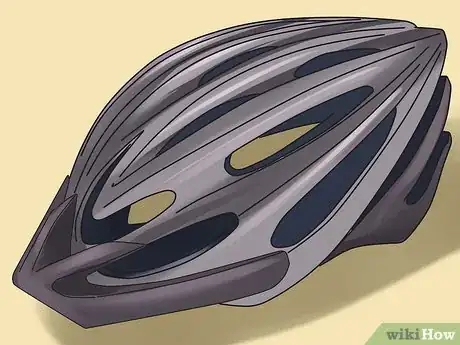
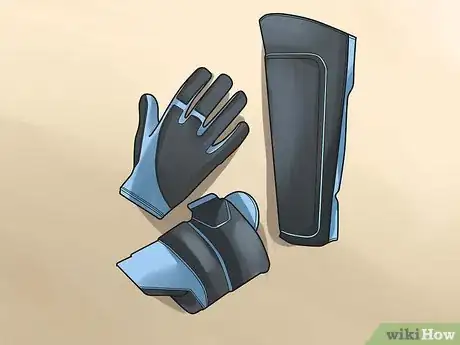
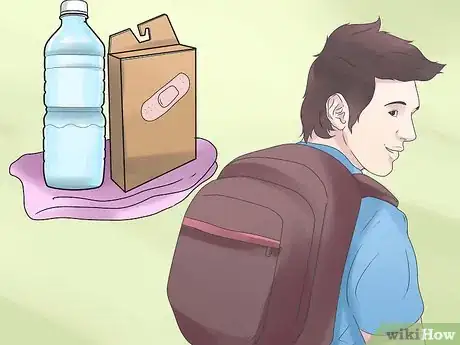


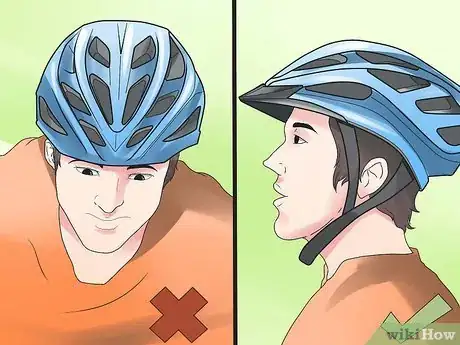
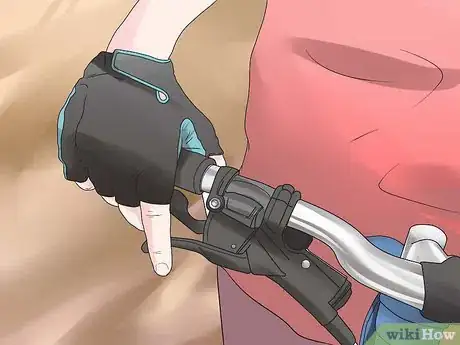
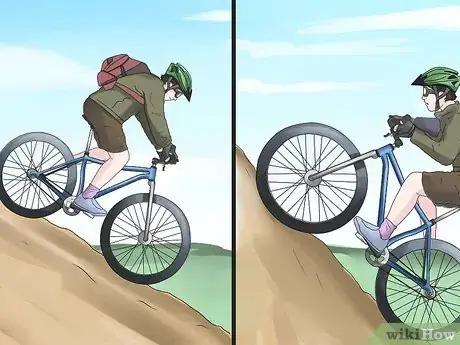
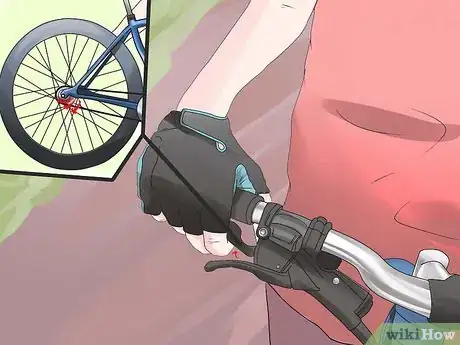
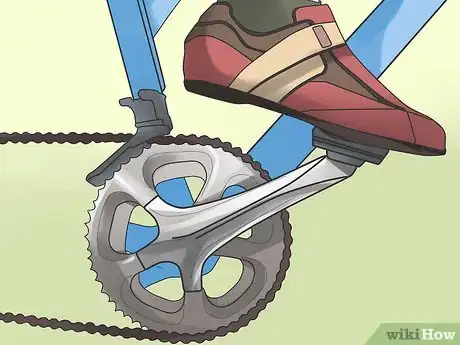
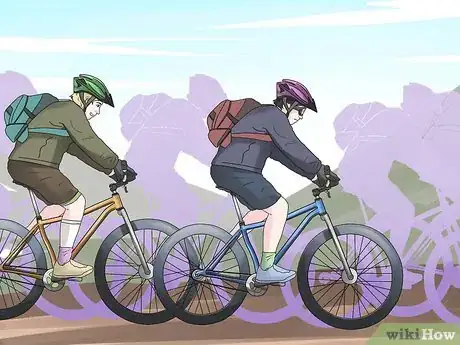


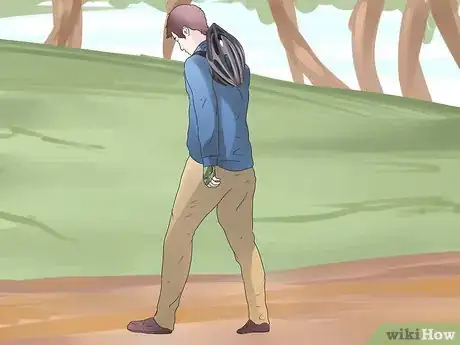
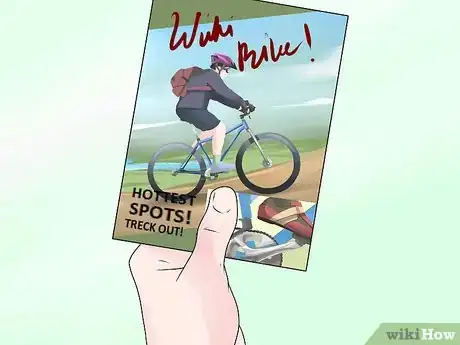
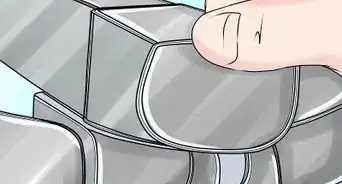

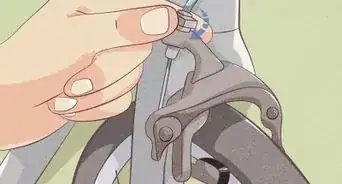
-Step-16.webp)


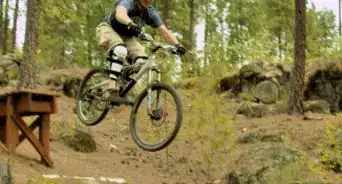









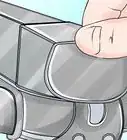

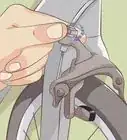
-Step-16.webp)


































